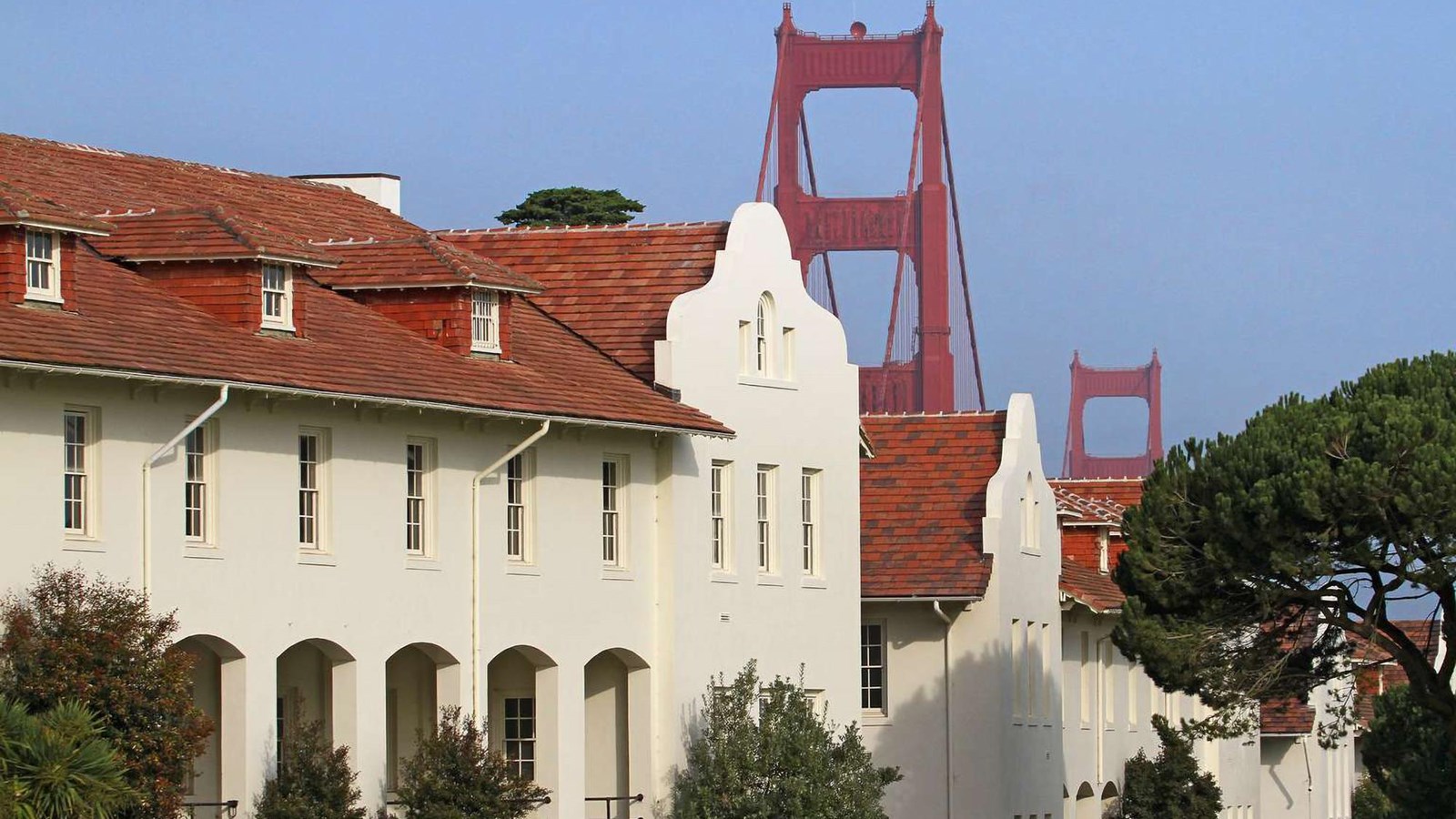Last updated: January 29, 2021
Place
Fort Winfield Scott

Historical/Interpretive Information/Exhibits
This beautiful campus, once its own US Army post dedicated to defending San Francisco Bay, introduced Mission Revival style architecture to the Presidio. Fort Scott offers amazing views situated near several trails and scenic overlooks. It's also the backdrop for popular volunteer stewardship activities at the Presidio Nursery and the surrounding area.
Fort Scott is home to the Presidio Institute, which provides transformational experiences to inspire and empower leaders across an array of fields to make positive impacts in their communities.
Get Your Nature On: Trails and Vistas at the Fort
The best way to enjoy the outdoors at Fort Scott is to park in the lot at Langdon Court off of Lincoln Boulevard. Go south to walk the Batteries to Bluffs Trail (featuring an in-app tour) which takes you to Marshall's Beach and points south, including Baker Beach. North of the lot is the Golden Gate Overlook, old coastal batteries and the Golden Gate Bridge.
History of Fort Winfield Scott
Prior to 1912, Coast Artillery soldiers lived at the Montgomery Street Barracks at the Presidio's Main Post, a good thirty minute march from the coastal guns where they performed their duties. Fort Winfield Scott significantly shortened their morning commute.
Between 1922 and 1946, the fort was designated headquarters of the Coast Defenses of San Francisco, commanding other coast artillery forts in the area, like Fort Barry and Fort Baker.
After the Pearl Harbor attack, the fear of Japanese invasion prompted Army command to station soldiers at the batteries 24 hours a day. Fort Scott became a place where shift-weary soldiers could enjoy a little rest and relaxation.
Old Fuss and Feathers
"Old Fuss and Feathers" is high in the running for greatest nickname of all time. The honor belongs to US Army General Winfield Scott, who served more time as an active duty general than any other commander in US history. His career began in the War of 1812, though his rise to prominence came during the Mexican War. He led the assault on the fort of Chapultepec, resulting in a Mexican surrender in 1847. The US victory against Mexico led to the annexation of California.
At the end of his illustrious career, his deeds earned him a second alias, "The Great Old Man of the Army," which is epic, but lacks a certain ring you get with his original moniker. Scott's also remembered for devising a blockade to defeat the Confederacy, and for being an insufferable crank.
Prisoners of Conscience
During the Vietnam War, the Presidio was a functioning US Army post complete, with its own stockade, used to jail enlisted men who had committed violations against their terms of service. In the late 1960s, 127 men were held at the Presidio as military prisoners. The majority were serving time for AWOL offenses.
123 soldiers were kept in Building 1213, a facility fit to hold a maximum 88. The conditions of the stockade were deplorable. The men were subjected to extreme cruelty from the guards, who the soldiers described as antagonistic and racist. Overcrowding resulted in insufficient meal portions and two hour wait times to use bathrooms overflowing with human waste.
While many prisoners suffered from mental stress and disorders, Private Richard "Rusty" Bunch, was particularly unstable. He was known to meditate in his cell, muttering that he'd been reincarnated and attempt to walk through walls. One day, Private Bunch asked a guard if he would shoot him if he ran, to which the guard replied he'd have to run to find out. Bunch did run, and the guard shot him in the back with a shotgun from ten feet away, killing him.
The Presidio Mutiny
The killing of Private Richard "Rusty" Bunch was the spark that led to the so-called Presidio mutiny. Upon hearing of Bunch's slaying, the prisoners were enraged, threatening violence against the guards. Ultimately, cooler heads prevailed. Instead of a violent outburst, 27 prisoners organized a peaceful non-cooperative demonstration where they sat in a field, sang protest songs and refused to move until meeting with Captain Robert Lamont, commander of the Presidio stockade.
When Lamont arrived, the protesters read him their seven demands which sought to improve conditions at the stockade, ensure psychiatric evaluations of prisoners and guards, and allow prisoners a chance to talk to the media regarding Bunch's killing. Lamont cut the men off and accused them of mutiny before having them forcibly returned to their cells.
The men were court-martialed, found guilty and handed sentences ranging from six months to 16 years. As often happens, justice arrived late. A year after the court-martial, the decision was reversed by judge Jacob Hagopian, who ruled that the men's actions did not meet the definition of mutiny, and the charges were dropped.
